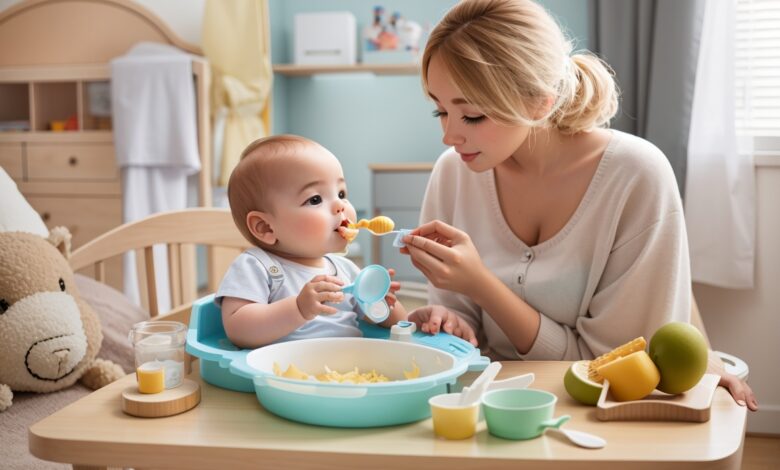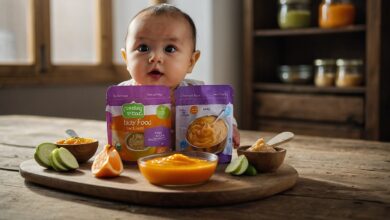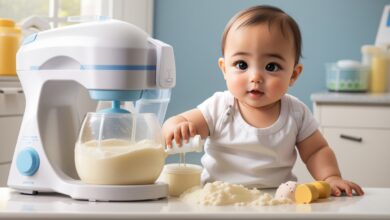The Ultimate Guide to Baby Feeding Set – Ensuring Nourishment and Convenience for Your Little One
Unlocking Convenience: The Ultimate Guide to Baby Feeding Set

Introduction to Baby Feeding Set
When it comes to feeding your precious little one, having the right tools can make all the difference. A baby feeding set is an essential investment for every parent, providing convenience, safety, and proper nutrition. In this ultimate guide, we will explore the importance of baby feeding sets and dive into the different types available in the market. We will also discuss the factors to consider before choosing a set to ensure it meets your baby’s specific needs.
Understanding the Importance of Baby Feeding Sets
Why Invest in a Baby Feeding Set?
Investing in a baby feeding set offers numerous advantages that can enhance your baby’s feeding experience. These sets are specifically designed to cater to the unique needs of infants and toddlers, making mealtimes a breeze for both parent and child.
Benefits of Using a Dedicated Feeding Set
Using a dedicated feeding set, as opposed to using regular utensils, ensures that your baby’s meals are delivered safely and appropriately. These sets often come with features that prevent spills, provide ergonomic grips, and promote self-feeding skills. Additionally, they offer a sense of familiarity and comfort, which can help create a positive mealtime routine.
Ensuring Proper Nutrition and Safety
One of the primary goals of feeding your baby is to provide them with proper nutrition. A baby feeding set can help you achieve this by ensuring that the food or milk is delivered at the right temperature, in appropriate portions, and in a hygienic manner. These sets are designed to prioritize safety, with materials free from harmful chemicals and age-appropriate features to prevent choking hazards.
Exploring Different Types of Baby Feeding Sets
Not all baby feeding sets are created equal. There are various options available in the market, each with its unique features and benefits. Let’s take a closer look at the different types of baby feeding sets you can choose from.
Traditional Feeding Sets
Traditional feeding sets often consist of a set of bottles, nipples, and utensils made from plastic or glass. These sets are widely used and trusted by parents worldwide. They are available in different sizes, shapes, and designs to accommodate the specific needs of your little one.
Silicone or Plastic-based Sets
Silicone or plastic-based sets have gained popularity in recent years due to their lightweight and durable nature. These sets are often flexible, making it easier for babies to hold and manipulate their feeding utensils. Additionally, they are less prone to breakage, making them a practical choice for on-the-go parents.
Eco-Friendly and BPA-Free Options
For environmentally-conscious parents, eco-friendly and BPA-free baby feeding sets are an excellent choice. These sets are made from sustainable materials and are free from harmful chemicals such as BPA, phthalates, and lead. By choosing an eco-friendly option, you can prioritize both the health of your baby and the planet.
 Factors to Consider Before Choosing a Baby Feeding Set
Factors to Consider Before Choosing a Baby Feeding Set
Choosing the right baby feeding set requires careful consideration of various factors. To ensure that the set meets your baby’s needs, keep these essential aspects in mind.
Age-Appropriate Features
Different feeding sets are designed to cater to specific age groups. When selecting a set, consider your baby’s age and developmental stage. Look for sets that offer age-appropriate features such as soft and flexible nipples for newborns or spill-proof cups for toddlers.
Durability and Longevity
Babies can be quite enthusiastic during mealtime, so it’s crucial to choose a feeding set that can withstand their explorative nature. Opt for sets made from high-quality, durable materials that can endure frequent use and occasional drops without compromising safety or functionality.
Ease of Cleaning and Maintenance
Mealtime can get messy, and cleaning the feeding set should be a hassle-free process. Look for sets that are dishwasher-safe and easy to disassemble for thorough cleaning. Avoid sets with intricate parts or hard-to-reach crevices that can harbor bacteria.
Essential Components of Baby Feeding Sets
To ensure a well-rounded feeding experience for your baby, a baby feeding set should incorporate various essential components. Let’s explore these components in detail.
Baby Bottles
Baby bottles are one of the most crucial components of a feeding set. They come in various materials, such as glass or plastic, each with its advantages.
Glass Bottles vs. Plastic Bottles
Glass bottles are known for their durability and ease of cleaning, as they do not retain odors or stains. They are also free from potentially harmful chemicals found in some plastics. On the other hand, plastic bottles are lightweight and less prone to breakage, making them suitable for travel and on-the-go feeding.
Nipple Types and Flow Rates
Nipples play a significant role in your baby’s feeding experience. Different nipples offer varying flow rates and shapes, simulating the natural breastfeeding process. It is essential to choose a nipple that suits your baby’s age and eating habits, ensuring a comfortable and efficient feeding experience.
Anti-Colic Features for a Comfortable Feeding Experience
Colic can be a dreaded experience for both parents and babies. To alleviate this discomfort, many baby bottles come with anti-colic features such as venting systems or specially designed nipples that reduce air intake during feeding. These features can help prevent excess gas and potential digestive issues.
Mealtime Accessories
In addition to baby bottles, mealtime accessories are essential components of a baby feeding set. These accessories can enhance the feeding experience and make it more enjoyable for both parent and baby.
Importance of Bibs and Burp Cloths
Bibs and burp cloths are essential for keeping your baby clean and dry during mealtime. They help protect their clothes from spills, spit-up, or drooling. Opt for bibs and burp cloths made from soft and absorbent materials to ensure your baby’s comfort.
Choosing the Right High Chair
As your baby grows, a high chair becomes an integral part of the feeding routine. When choosing a high chair, consider its stability, safety features, and adjustability. Look for high chairs that are easy to clean and have removable trays for convenience.
Innovative Utensils for Self-Feeding Development
As your baby transitions to self-feeding, innovative utensils can support their developmental milestones. Look for utensils with soft-grip handles and curved shapes that promote easy grasping and self-feeding skills. Some utensils come with protective features to prevent accidental injuries, such as temperature-sensitive tips or silicone coatings.
Storage and Feeding Containers
Proper storage and feeding containers play a vital role in maintaining the freshness and safety of your baby’s food. Including these components in your feeding set ensures that you can store, freeze, and reheat food with ease.
Baby Food Jars and Containers
Baby food jars and containers are available in various sizes and designs. Opt for containers made from BPA-free materials that are microwave-safe and freezer-friendly. Look for containers with secure lids that prevent leaks and maintain the freshness of the food.
Freezing and Reheating Options
Some baby feeding sets come with freezer trays or portioned containers specifically designed for freezing and reheating baby food. These trays allow you to prepare and store homemade baby food in small, individual servings, ensuring that you always have a fresh and convenient meal ready for your little one.
Tips for Organizing and Managing Baby Food Inventory
Proper organization and management of your baby’s food inventory can save time and reduce waste. Consider using a labeling system to keep track of the expiration dates and contents of each container. Utilize storage solutions such as stackable containers or storage racks to maximize space and keep everything easily accessible.
Health and Safety Considerations
Maintaining proper hygiene and safety standards is paramount when it comes to baby feeding sets. Let’s explore the key considerations to ensure the health and well-being of your little one.
Maintaining Proper Hygiene and Sterilization
Maintaining cleanliness and sterilization of your baby’s feeding set is vital to prevent the growth of bacteria and ensure their overall health. Implementing proper cleaning and sterilizing techniques is crucial for a safe feeding experience.
Cleaning and Sterilizing Techniques
To clean baby feeding sets, start by rinsing off any remaining residue with warm water. Use a mild dish soap and a bottle brush to scrub all parts thoroughly. Rinse off the soap residue and sterilize the set by boiling it in water or using a steam sterilizer. Be sure to follow the manufacturer’s instructions for specific cleaning and sterilization methods.
Avoiding Bacterial Contamination
Bacteria thrive in moist environments, making it essential to keep all baby feeding set components dry between uses. After sterilization, allow the pieces to air dry or dry them with a clean towel. Avoid using abrasive materials that may damage the equipment or leave behind lint.
Ensuring Safe Storage of Feeding Sets
Once your baby feeding set is clean and dry, proper storage is crucial to maintain its cleanliness and safety. Store the set in a clean and dry place, away from direct sunlight and potential contaminants. Using separate storage containers or bags for individual components can help keep them organized and easily accessible when needed.
Identifying Allergen-Friendly Baby Feeding Sets
Food allergies are a concern for many parents, and choosing an allergen-friendly baby feeding set can provide peace of mind. Consider the following factors when selecting a set that caters to your baby’s potential allergies.
BPA and Phthalate-Free Materials
BPA and phthalates are chemicals found in some plastics that may have adverse health effects. Opt for baby feeding sets made from BPA and phthalate-free materials, such as glass or BPA-free plastics, to minimize the risk of exposure to these harmful substances.
Anti-Allergenic Nipples or Teats
Some babies may have sensitivities to certain materials, such as latex or silicone. Look for feeding sets that offer anti-allergenic nipples or teats, which are often made from hypoallergenic materials such as medical-grade silicone. These nipples are designed to minimize the risk of an allergic reaction.
Addressing Common Allergen Concerns
If your baby has known food allergies or intolerances, consult with a healthcare professional to determine the best feeding set options. They may recommend specialized feeding sets that cater to specific dietary restrictions or allergic reactions. Always read the labels and product descriptions carefully to ensure that the feeding set is suitable for your baby’s needs.
Temperature Control for Optimal Nutrition
Maintaining the right temperature during feeding is vital to ensure your baby receives optimal nutrition and to prevent potential injuries. Consider the following guidelines for temperature control when using baby feeding sets.
Safe Bottle and Food Warming Techniques
Baby bottles and food can be warmed in various ways, including using warm water baths, bottle warmers, or microwaves. It is crucial to follow the manufacturer’s guidelines and recommendations for each specific method to avoid uneven heating or overheating risks. Always test the temperature of the food or milk before feeding to ensure it is comfortable for your baby.
Choosing the Right Temperature for Feeding
Different babies may have different preferences when it comes to the temperature of their food or milk. As a general guideline, aim for a lukewarm temperature that mimics breast milk temperature. Avoid serving food or milk that is too hot, as this can cause burns or discomfort.
Preventing Burns and Overheating Risks
To prevent burns, always test the temperature of the baby’s food or milk on the inside of your wrist before serving. Be cautious when using microwave heating methods, as they may heat unevenly and create hot spots. Stir or shake the bottle well after heating to distribute the heat evenly and preve
nt any potential burns to your baby’s mouth.
Tips for Using and Maintaining Baby Feeding Sets
To make the most out of your baby feeding set and ensure its longevity, here are some essential tips to keep in mind.
Introducing Solids and Transitioning from Breastfeeding
Transitioning your baby from breastfeeding to solids is an exciting milestone. Here are some guidelines and tips to make the transition smoother for both you and your little one.
When introducing solids, start with single-ingredient purees, such as mashed fruits or vegetables, and gradually increase the texture and variety. Pay attention to your baby’s cues and consult a healthcare professional for personalized guidance. Introduce new foods slowly to monitor for potential allergies or sensitivities.
Introducing Different Textures and Flavors
As your baby grows, introduce a variety of textures and flavors to expand their palate and encourage healthy eating habits. Experiment with mashed, pureed, and soft finger foods. Offer a range of flavors and encourage self-feeding to promote independent eating skills.
Advice for Successfully Transitioning to Solids
Transitioning to solids can be messy and challenging at times, but with patience and perseverance, it can be a fun and rewarding experience for both you and your baby. Create a positive mealtime environment by sitting together at the table, engaging in conversation, and making feeding a relaxed and enjoyable experience.
Cleaning and Maintaining Baby Feeding Sets
Proper cleaning and maintenance of your baby’s feeding sets are essential for hygiene and safety. Follow these step-by-step instructions to ensure your feeding set remains in optimal condition.
Step-by-Step Cleaning Instructions
After each use, disassemble the feeding set and rinse off any remaining residue with warm water. Use a mild dish soap and a bottle brush to clean all parts thoroughly. Pay extra attention to bottle nipples or teats, ensuring there are no clogs or leftover food particles. Rinse off all soap residue and allow the components to air dry or dry them with a clean towel.
Proper Handling of Nipples and Teats
Nipples and teats should be inspected regularly for signs of wear and tear. Replace them if they become cracked, damaged, or show signs of deterioration. Store nipples and teats in a clean and dry place to prevent contamination. Avoid exposing them to direct sunlight or high temperatures, which can cause the material to degrade.
Troubleshooting Common Cleaning Issues
Sometimes, cleaning baby feeding sets can present challenges, such as stubborn stains or lingering odors. For persistent stains, try soaking the components in a mixture of warm water and baking soda or using specialized bottle cleaning solutions. To remove odors, soak the items in a mixture of warm water and white vinegar for several minutes before washing and rinsing thoroughly.


 Factors to Consider Before Choosing a Baby Feeding Set
Factors to Consider Before Choosing a Baby Feeding Set



